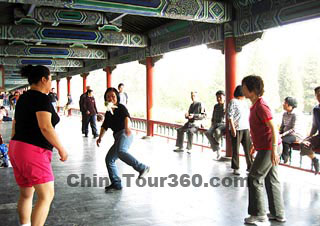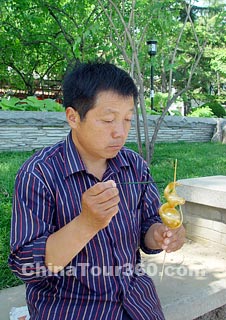 |
| Kick a Shuttlecock |
Chinese folk toys enjoy a history as old as the nation itself. Revealing aspects of the land and its rich cultural heritage, they portray the wisdom and creativity of folk artists throughout China. Many practical, instructive and artistic folk toys are favored by children and adults alike. Furthermore, these toys serve as a means through which Chinese people can express their hopes and desires, as well as their affection towards their children. Infused with a multitude of meanings, from the instructive to the decorative, folk toys bring beauty and art into ordinary lives.
![]() Playing with History
Playing with History
Colorful glass marbles with flowers or other designs inside of them are quite popular among children across China. Used in a variety of games, these toys, like the children who play with them, have their own ancestral history.
Among the relics unearthed from the ruins of Banpo Village in Xian were some small clay and stone balls dating back to the Yangshao Culture of the Neolithic Period (4800-4300 BC). Archeologists believe them to be ancient children's toys. The diameter of these balls varies from 1.1 cm to 3 cm, too small and light to be used as bullets or other weapons. Some of the clay balls have decorative prints and scratches on them. In addition, small pottery and glazed porcelain balls from a later period (4400-3300 BC) have been unearthed from the ruins of Wushan Mountain in Sichuan Province. Scholars argue that because they are more durable and decorative than the earlier clay and stone balls, these are the precursors to the contemporary glass marbles so popular today.
A large number of masks and centimeter-long toys in the shapes of animals such as dragons and lions have been found in several other ruins. Closely linked to the lives of rural people in ancient China, these toys were undoubtedly enjoyed by both children and adults as their contemporary counterparts are today. In today's China, masks and statuettes in the shape of historical characters, beasts, and other animals can be seen in the hands of many children.
![]() Toy with Sounds
Toy with Sounds
Toys with pleasing, rhythmic sounds have always been favorites of children. Parents sing lullabies and whistle tunes to coax their children to sleep, but folk toys that make simple soothing sounds are equally effective. Small cymbals, bells and little gongs, familiar instruments of traditional Chinese folk music, along with shaking-drums and bird-shaped whistles are among the most popular and common toys, particularly in rural areas.
Whistles of various kinds are perhaps the most common musical toys. In ancient times, whistles were made and used by hunters. At Tieshan Town in Lushun City, a saddle-shaped pottery whistle dating back to the Neolithic Period has been unearthed and, when blown, produces a sharp sound. In later periods, clay cuckoos and other bird-shaped whistles were made. Together with other musical toys, they have been handed down from generation to generation. Today children on city streets as well as those in the countryside enjoy blowing clay and plastic bird whistles.
Another popular musical toy is the bamboo flute. Bamboo can be found everywhere in southern China and musical toys made out of bamboo tubes along with those made of reed pipes are quite popular. The beautifully sounding bamboo flute, which has several holes drilled into a piece of bamboo, can be blown horizontally or vertically. A traditional musical instrument, it continues to be widely played by both adults and children. Another traditional wind instrument for children is the Sheng, which is made of several reed pipes bound together with an attached mouthpiece. Like the bamboo flute, these reed-pipe instruments have a long history in Chinese culture and are still popular today.
![]() Moving Toys
Moving Toys
Ancient artisans were capable of producing elaborate movable toys. Using ordinary materials and simple tools, they made toys that were not only fun to play with but also objects of great beauty.
Clay 'roly-poly' figurines are often seen for sale at country fairs. Funny and attractive, these figurines revolve on spherical clay pedestals and never fall down, even when lightly struck by children. Cloth lions and tigers open their mouths and shake their heads or tails when a hand is placed inside the toy's body. Chickens can be made to move their heads up and down as if they were pecking at rice.
Among movable toys, shadow puppets enjoy the longest history and best reputation. Made of colored cardboard, leather, or hardened sheets of plastic, they are used by children and adults in a variety of puppet shows. With wires, strings, or sticks attached to them, the puppeteers can move various parts of their bodies.
Similarly made furniture is also used as scenery in puppet shows. Many of the sets and characters are from folk literature. Increasingly, however, contemporary figures of soldiers, workers, and peasants enjoy popularity among children. Reflecting various aspects of modern life, these puppets provide a medium for both artists and consumers to express their ideas, concerns and desires. Moreover, as certain figures grow in popularity and demand, the puppets constitute a kind of cultural record, which enables scholars and others to view changes in and attitudes about Chinese culture.

A Sugar-molded Toy
![]() Toys of Practical Use
Toys of Practical Use
Toys are most often seen in terms of their ability to amuse. However, the Chinese people, who are known for their thrifty and practical nature, make toys for other purposes as well.
Foodstuffs have long served as a source for artistic creation. Culturally expressive and emphasizing traditional materials and culinary devices, some foods serve not only the need of eating but also the purpose of playing. A good example is the sugar-molded figurines popular throughout China.
Sugar-molded toys are children's favorites. Melted sugar is poured into wooden or metal molds, which are carved with various patterns. The most common motifs are chickens, fish, pigs, horses, lions, and tigers. Candy figurines are also made without molds. In city parks, candy-making artists create various figures with a few quick strokes of a spatula. Fun to observe and eat, these figurines represent figures and designs important in Chinese culture.







